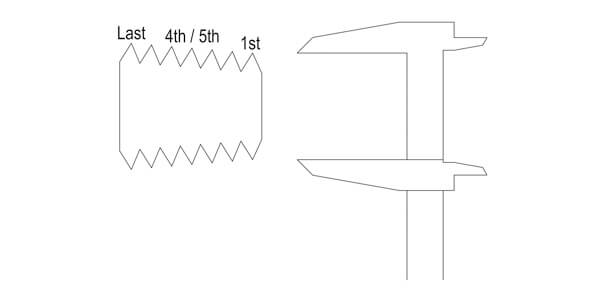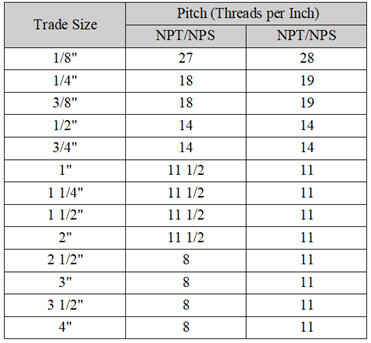
NPT threads are common in the United States and a few other countries, BSP threads (also know as the R subset according to ISO 7) are widely used in many other countries.
- BSPT -British Standard Pipe Taper
- BSPP -British Standard Pipe Parallel (G)
- NPT -National Pipe Taper
- NPS -National Pipe Straight
- R – External taper (ISO7)
- Rp – Internal Parallel (ISO7/1)
- Rc – Internal Taper (ISO 7)
- Rs – External Parallel
While the actual specified outside diameters of American National Pipe differ slightly from those of British Standard Pipe, either thread may reliably be cut onto a pipe of its respective trade size. BSPT equivalent is NPT and BSPP’s equivalent is NPS.
Never swap threads if it is a high pressure application.
NPT/NPS and BSP threads are not compatible due to the differences in their thread forms, and not just the fact that most sizes have a different pitch. NPT/NPS threads have a 60° angle and have flattened peaks and valleys (Sellers thread form) where as BSP threads have a 55° angle and have rounded peaks and valleys (Whitworth thread form).
NPT and BSP thread pitches (threads per inch) are listed below. To determine pitch, use a thread gauge or count the number of threads that fall into a 1″ span.

How to Measure Threads
To identify the trade size of the thread, first it must be determined whether the thread is tapered or parallel. This is done by measuring the first, fourth/fifth and last full thread. If the diameter increases from first thread to the last thread on a male thread or decreases from first to last thread on a female thread, then the thread is classified as a tapered thread (such as BSPT). If the diameter stays the same from the first to last thread then the thread is classified as a parallel thread (BSPP).

Once it is known whether the thread is parallel or tapered, it can be measured to determine it’s trade size. This trade size will not directly represent what is measured, ie. 1/2” BSP does not equal 1/2” measured.
For a parallel thread, any thread can be used to measure for its trade size, and for a tapered thread the fourth or fifth full thread is used. This measurement can then be referenced against a thread table to match it to its trade size.
QC Hydraulics has more than 20 years machining experience, and we have rich experience on thread, if you have any questions about NPT and BPS and other thread, please let me know.
